Oh, Japan. Land of got-to-collect-them-all, including hundreds of castles in varying levels of existence. There are thousands of ruins from almost indistinguishable mounds to castle walls with no castle structures. Most of the castle keep structures are reconstructions but there is the crème de la crème, 12 original castles from the pre-Meiji era. The 100 Famous Castles in Japan (日本百名城, Nihon Hyaku Meijō) were chosen by the Japan Castle Foundation (日本城郭協会, Nihon Jōkaku Kyōkai) followed by another 100 after that! When you have so many to check off your list, how do you keep track of them all? Why, a castle stamp rally, of course!
- Japan and Numbered Rankings
- Japan Castle Foundation (日本城郭協会)
- The 100 Famous Castles in Japan (日本百名城, Nihon Hyaku Meijō)
- Continued 100 Famous Castles in Japan (続日本100名城)
- 12 Pre-Meiji Era Castle Keeps in Japan
- Where did all the Japanese castles go? Meiji Restoration
- How to become a castle expert
- Types of Castles in Japan
- Layout and Structures of Japanese Castles
- What is the Stamp Rally?
- Should you visit castles in Japan?
- 100 Famous Castles in Japan by Region
- Continued 100 Famous Castles in Japan by Region
- Other Castles in Japan
- Pin this for later
[Editors Note: This post was originally published in December of 2018 and has been updated for freshness, accuracy, and comprehensiveness.]
Japan and Numbered Rankings
Hundreds of years ago, a Confucian scholar created clickbait before it was even a thing! I just made that up but it’s conveniently similar. As he traveled Japan he named the three best views of Japan (日本三景, nihonsankei). Itsukushima Shrine is one of them and since then there have been countless “Best three of Japan” in various categories.
Legit. As in these are not to be contested. They are the best.
Top 3 gardens (Kairakuen in Mito, Ibaraki; Kenrokuen in Kanazawa, Ishikawa; and Kōrakuen in Okayama, Okayama); Top three big buddhas (三大大仏, sandai-daibutsu, you’ve seen me talk about Todaiji in Nara and you’ll soon hear about Kamakura and Takaoka’s as I’ve been to them as well); and so many others. Three great onsens, caves (Ryusendo is amazing), shrines of all sects (and of course Fushimi Inari in Kyoto is one), night views.
Name it. They exist.
Well, there’s also a thing with the number 100. We’ll blame that one on the Billboard Top 100 but I honestly don’t know if they are correlated. What started as the 100 top mountains in Japan (as best I can tell it was the first and of course Mount Fuji is number one) has since spread to other aspects.
Great way to make a book. An even better way to entice a massive tourism industry! Start with the peaks, move on to the 100 best shrines, 100 best spots to view cherry blossoms, 100 best parks, and then we have the 100 best castles.
Japan Castle Foundation (日本城郭協会)
The Japan Castle Foundation (日本城郭協会, Nihon jyoukaku kyoukai) was founded in 昭和31年4月 (April of Showa 31 or 1956 for the rest of the world) by a bunch of academics for knowledge sharing and cultural exchange. They aren’t just about Japan castles, they also study castles around the world. Along with the 100 Famous Castles in Japan and the Continued 100 Famous Castles in Japan, they also have a list of 100 Famous castles in Europe.
In Showa 67 (1965), the Ministry of Education acknowledged them as an organization and as such were given a budget. On their 40th anniversary as a foundation, a project to commemorate the event was started. Deciding on the top 100 Famous castles in Japan to promote.
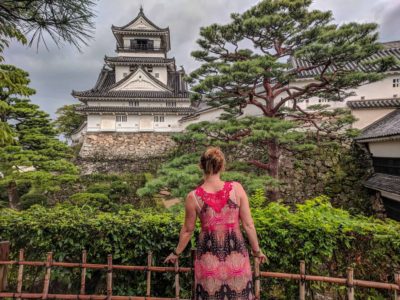
Kochi Castle, one of the 100 Famous Castles in Japan and remaining original constructions
The 100 Famous Castles in Japan (日本百名城, Nihon Hyaku Meijō)
Don’t ask me why or when I started but I normally prefer translating “百名” as “hundred finest” as opposed to “hundred famous” (as what it literally is) but I think it has a better ring to it. But alas, you’ll see in a second why famous is a better fit.
For several months in 2005, they reached out to residents to give recommendations of one to five top castles in each prefecture. From the applications, a panel of castle experts met to decide the fate.
Honestly, I bet there was a huge debate over some of them! Only 5 max a prefecture?! By the Japan Castle Foundations prediction, there are probably somewhere in the range of 40-50 THOUSAND castle remains in Japan.
For the selection process from all of the entries, each castle had to meet one of the following three criteria to be considered one of the famous castles in Japan.
- Being an excellent cultural property or historical site (think world heritage Himeji Castle or one of the National Treasure like Hikone Castle)
- Played a prominent role in history (not all castles saw battle)
- Are representative of an era or region
That last one gets me because I’m sure they all in some way represent their regions. After all, a giant majority of Japan’s cities started as castle towns! But remember, your prefecture gets five max! The discussions of what made each better than the next must-have been fascinating.
To help make sure the rankings weren’t biased by people’s favorite castles, they brought in experts in various fields such as architecture, archeology, civil engineering, and history to level the playing field.
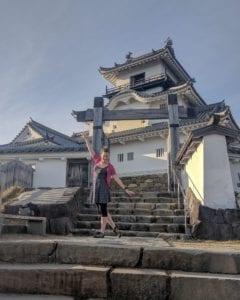
Kakegawa Castle – No. 42 of the 100 Famous Castles in Japan, is an easy trip from Osaka or Tokyo! It was rebuilt using original construction methods and Kakegawa also has one of the few remaining palaces in Japan.
One thing to note, though they are labeled 1 to 100 the 100 famous castles in Japan are not in rank order but numbered according to the location from North to South and East to West. There are some slight variations to that but for the most part, it works.
Continued 100 Famous Castles in Japan (続日本100名城)
In 2017, as part of their 50th anniversary of the founding of the castle foundation, they created an additional 100 list. 続日本100名城, Zoku Nihon Hyaku-Meijō. Continuation of the 100 castles to help further promote castle, and therefore history, discovery.
Personally I think it was also a ploy to promote more tourism around the country, but I’ll take it! The conditions were the same and again, they went out to each prefecture for submissions but this time they also asked the Japan Castle Foundation members, and those that had been going to the original list of 100 castles.
So, if you like castles, you have 200 stamps to go collect. And don’t forget those other 40,000 castles (yes, thousand) potential castles in Japan. Like a third Matsuyama Castle hidden in the hills near the Yoshimi Caves in Saitama.
Disclosure: Kristenabroad.com is a participant in the Amazon Services LLC Associates Program, an affiliate advertising program in which I may earn a small commission by linking to Amazon.com and affiliated sites. Price to you is not affected! It helps me do what I love, share Japan with you!
12 Pre-Meiji Era Castle Keeps in Japan
While they are often referred to as the 12 original castles in Japan, this sentiment applies to the original construction of 12 castle main keeps still in existence today. The Japanese term for them is 現存天守 (genson tenshu).
What’s with there only being 12? Well, when things are made of wood… it’s easier to burn down! Not to mention the deconstruction of many castles during the Meiji Era (more on that in a bit) and well,… bombings.
If you are seeing this list of 100 castles and thinking “Oh god, how will I ever get through that list on my trip to Japan?!”, I highly recommend you start with the 12. If you are going to call any famous castles in Japan – it’s these!
That being said, they also are spread throughout the islands of Honshu and Shikoku but that just gives you an excellent way to make the most out of your Japan Rail Pass! You’ll also get to the experience of riding on Japan’s fastest shinkansen (or bullet train) if you follow my suggestions on how to get to Aomori to see Hirosaki Castle.
As one of my must-do missions, I have focus posts on all of them so make sure to check out this post about the 12 remaining original castle keeps of Japan.
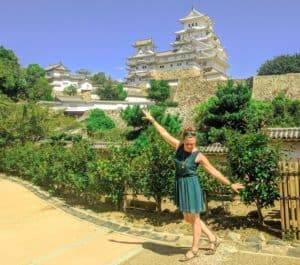
Where did all the Japanese castles go? Meiji Restoration
You may have heard of Commodore Perry taking a fleet of American warships and knocking on Japan’s door, so to speak, in 1853 to open up the borders. This was the start of the end of Japan’s isolation from the world. You see, during the Tokugawa shogunate run period of Edo, they cut off Japan near completely.
However, as their power was getting weaker, there was a movement to restore the imperial throne. There was always an emperor, the Chrysanthemum Throne is the longest-running hereditary monarchy in the world! But the shogunate was calling the shots. Anyway, Emporer Meiji (hence it being called “Meiji Restoration”) was reinstated and they had to make sure they knew who was boss.
So they systematically dismantled near all of the existing Japanese castles that acted as the dwelling place of the shogunate rulers.
There’s lots to learn about castles in Japan!
How to become a castle expert
If you are familiar with the Japanese Language Proficiency Test (JLPT), this set up is going to sound similar. In order to further promote the castles in Japan and “lifelong learning”, a test was created to challenge people’s knowledge. It started in November of 2012 and has been growing in size with over 20,000 people taking it! There are now five levels of the test.
- Level 4, Beginners with an average passing rate of 96.7% has general knowledge of the famous castles in Japan
- Level 3, Elementary level with a more detailed understanding of construction, history and culture mostly focused on the 100 famous castles in Japan but also has questions from the continued list
- Level 2, Intermediate level has a deep understanding of the particulars of the 200 famous castles in Japan
- Semi-Level 1 (that’s just funny to me), Difficult level in which you are a つわもの or warrior returning to the castle (literally, that’s how they describe it!). It’s themed every year
- Level 1, Expert level. You’ve made it! You’re an expert!
It starts out with questions like “What’s the only pre-Meiji castle remaining in Tohoku?” (Answer: Hirosaki Castle) and raises in difficulty to things like “Castle X was decorated with paper lanterns to see which missionary off?” (I’m not bothering with that full question example because, what?!).
The test is administered twice a year in Fukuoka, Himeji, Nagoya, Osaka, Sendai, and Tokyo.
For some of the basics on Japanese castles, keep reading!
Types of Castles in Japan
If it looks like a castle, talks like a castle and walks like a castle… ok, maybe not walks. Japanese castle structure is very distinctive from the rest of the world.
The geography can play a big role in each design. There are three main types
- 山城 (yamashiro) or mountain castles
- 平山城 (hirayamashiro) or flat mountain castles, these are on hills on a plain
- 平城 (hirashiro) or castle on the plains
With the obvious advantage to the mountain and flat mountain castles for their defensive structures. However, castles on plains have their places as well and often would be incorporated into nearby waterways for an automatic moat.
Layout and Structures of Japanese Castles
There are many components that make up a Japanese castle. You may think when planning your trip around Japan that you don’t need much time in a castle. Believe me, some of them can take you all day! And you don’t want to miss out on some really cool features and even museums that many of them have!
Castle Keep
What most people think of as “THE CASTLE” for Japan is usually the 天守 (tenshu) or castle tower/keep (also called a donjon). There are four main types and my absolute favorite is Matsuyama Castle with its square design and center courtyard.
- 独立式天守, Independent Castle Tower.
- 複合式天守, Compound Castle Tower which has a 付櫓 or attached tower with the main tower
- 連絡式天守, Contact Type Castle Tower. That one doesn’t translate very well. It has a main castle tower with a 渡櫓 or crossing tower (think like a hallway) connecting to another 小天守 or smaller castle tower
- 連立式天守, Coalition Castle Tower. Think of this one as having a courtyard in the middle. A main castle keep with three smaller castle towers connected by hallway towers.
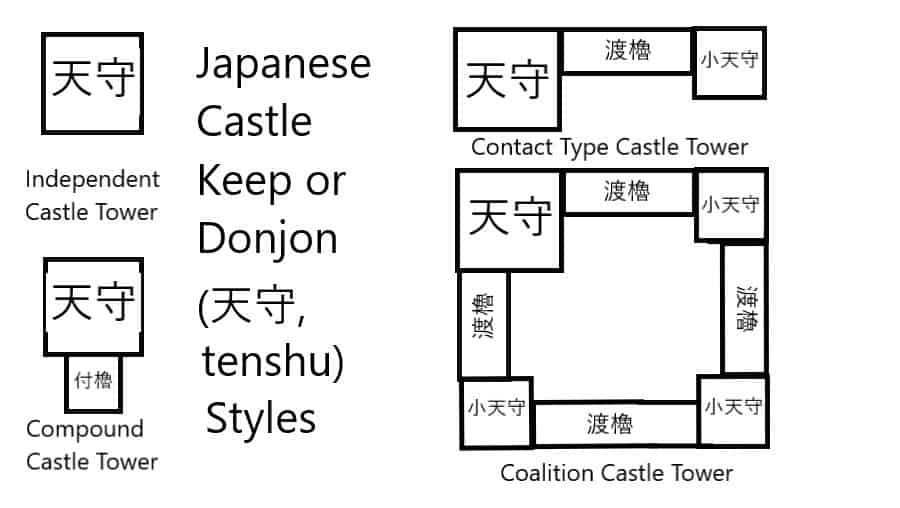
Looking from the outside of castles in Japan, they vary in “levels” usually from 3 to 6. The part of a Japanese castle that makes it look like a layer cake. But the amount of floors inside might be very different from what you see on the exterior!
Be cautious in the older castles, and even some of the remakes, the staircases are more like what you would see on a Navy ship. More ladder than stairs. Why is this? If the enemy made it inside it was harder to move up the floors!
It should be noted that a good majority of castles in Japan no longer have a tenshu. It was the symbol of power and usually the thing to go during the Meiji Restoration.
If you’re looking for the full effect, make sure to choose one that either from the pre-Meiji era (my recommendation if you are limited on time) or for a rebuilt one. On that note, not all rebuilds are created equal! Most are just concrete facades housing museums. Kakegawa and Kanazawa are two options for new builds using old construction techniques.
Citadels
If you aren’t as familiar with castle terminology, think of the citadels or baileys as the areas protected by the castle walls. Of which you can have multiple layers of defense.
The castle towers are located in the 本丸 (hon-maru) or inner citadel/bailey. There are generally two more baileys, 二の丸 (ni-no-maru, literally ‘second circle’) and 三の丸 (san-no-maru, third circle) in most castles but it’s not limited. They don’t always have those names either. Some times it can be the “east circle” or something similar.
Inside each would be where people lived, things like storehouses and the palaces existed – of which, you think original Japanese castle structures are rare, the palaces are even more so! Nijo Castle and Kakegawa Castles ninomaru palaces are two great options, as well as Kawagoe’s Honmaru Palace.
Overarching layouts
If you want to pay closer to any specific detail, this is the one I’d choose. Why? Because you can use it to decide on different castles to go to so you can see each style and don’t go to the same thing over and over again. Something that I feel happens a lot with shrines and temples so after a while, “they are all the same”. We don’t want that, too many awesome castles to see!
If the circle in the name didn’t give it away, one of the main overarching layouts would have them in 輪郭式 (ring fortification) or concentric circles (really squares but we’re sticking with the ‘maru” here which means circle). 二条城 (Nijo Castle) in Kyoto is this style.
There are three other styles:
- 連郭式 or a continuous string from one bailey to the next, in a row like 水戸城 (Mito Castle)
- 梯郭式 or ladder fortification, think… I honestly can’t think of how to describe this in English. Like an L-shaped staircase, I suppose. 岡山城 (Okayama Castle) is this style.
- 渦郭式 or spiral fortification, which is just like it sounds and is part of the reason 丸亀城 (Marugame Castle) is a pain to hike up to!
But of course, there are exceptions to the rule, not all topographies fit into a pretty box.
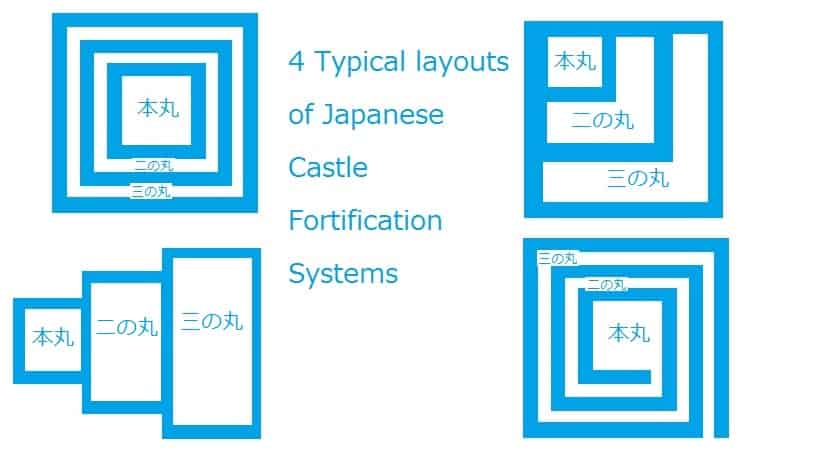
Other structures of Japanese Castles
When you are exploring castles make sure to take note of all the different aspects, they aren’t just the castle keeps! There are plenty of Important Cultural Properties mixed in – Himeji Castle has different designations on 80+ of its buildings and structures! Some things to look out for:
- 櫓 (yagura) or watchtowers that make the outer ring of citadels include the new construction at Kanazawa using old techniques. Fun fact: 櫓 (yagura) is also the kanji that is used for the structure of my favorite piece of Japanese furniture – Kotatsu!
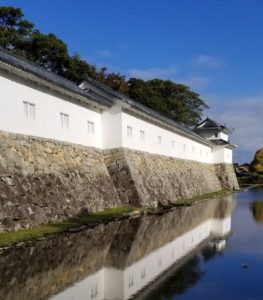
- 門 (mon) or gates! All of the gates! Many of the castles that are just walls remaining generally have at least a gate left that dates back to other eras like the one at 鳥取城 (Totori Castle).
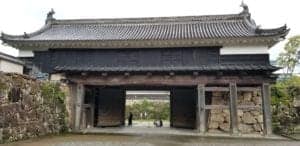
- 石垣 (ishigasa) or stone walls. 丸亀城 (Marugame Castle) has the highest in Japan. There is also some really cool engineering that goes into the different styles of stone wall construction.
- 堀 (hori) or moats. Some of the most beautiful are Edo Castles in my opinion.
Defenses
Also keep an eye out for some cool defense systems! And by cool I mean I’m glad I haven’t had to come face to face on them during a battle!
What is the Stamp Rally?
Fun thing about the 100. Japan’s good for stamp rallys. All over. You can get stamps for nearly anything. It’s a way of commemorating your visit. And it’s a fun hobby to “catch them all”. I reference Pokemon a lot. It’s just a Japan thing, let it go!
In 2007, a stamp rally was added to go along with the 100 Finest Castles in Japan list. The goal was to entice people to deepen their knowledge of the history of Japan and with the stamp book, it helped increase interest in castles.
To top it off, the stamps are very pretty so they can be used to commemorate your visit. And the Japan Castle Association also makes it clear on their website that they don’t intend for people to run around like crazy trying to get them all at once. Take your time and enjoy it!
Certifying your castle visits
Certify what? Yes, not only can you just go around Japan getting pretty stamps, you can have them certified complete and given a special recognition.
A couple of ways to get your stamp rally book, you can sign up to be a member of the foundation or you can purchase the book separately. As you are reading this on an English website, the latter option is probably best.
You have two options for books that I recommend as I have both. One has the stamp book built-in (日本100名城に行こう 公式スタンプ帳つき) and therefore will be a bit heavier to carry around. The other is a guidebook that comes with a separate stamp book pamphlet in the back (日本100名城公式ガイドブック (歴史群像シリーズ)).
Both are in Japanese but you’ll still be able to match the pictures with the castle and they are all numbered.
Only a few castles have these available in their gift shops so make sure you prepare ahead of time and order one!

Where to get your stamp?
Be watchful as there are LOTS of stamp rally’s in Japan and actually, when we were at Inuyama, there were no less than 5 stamps to get. Side note: It’s good just to have a blank book with you while you are traveling in Japan! I’ll talk more about goshuin (shrine stamp books) later.
Each of the books as one of the facts on the castle gives you the location of the stamps. That’s not very helpful if you can’t read Japanese (and if you are looking at learning I suggest Minna no Nihongo and Wanikani to get you started).
You can normally find them at the register for those castles with a main keep or somewhere inside. Throw on Japanese pronunciation and ask for the “スタンプラリー” (stamp rally spelled in Katakana) and you’ll get there. There are also sometimes signs if they are in other buildings like this one at Inuyama Castle.
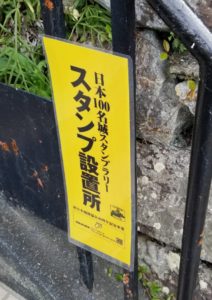
If you’re at one of the castles that don’t have a keep, often time there is a municipal building or museum on the grounds that have the stamp. The stamps are sometimes even at shrines.
I’ve definitely wandered around in circles on large castle grounds trying to find the stamps so when you read my posts about them, I will promise to try and always tell you where they are!
Making it legit
If you are eventually looking to get your certification, you MUST get the stamp in your book. Some places will have paper available and they say they will take that but best be safe and do as directed (also in Japanese, inside the books).
Each castle has a specific color ink to use so you’ll only see one of four colors, black, red, blue or green. Speaking of extra pieces of paper, it’s a good idea to have some to make sure it doesn’t bleed onto the other page.
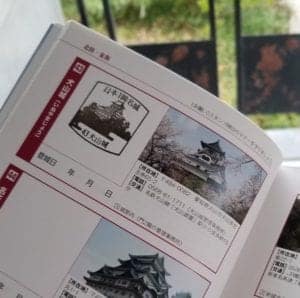
As Inuyama is an actual National Treasure, a higher designation than even some of the original 12 castles. Don’t let it being number 43 in the 100 finest castles confuse you. They are in order from North to South, East to West (mostly).
Oh, and make sure to mark which day you were there under the stamp! The blank spaces are year 年 – month 月 – day 日.
Should you visit castles in Japan?
If you are a history buff, or just like architecture, or have a hankering for some culture, I highly suggest you plan to see some of the 100 famous castles in Japan while you are in visiting.
Or, why not collect them all? My absolute favorite (and I’ve been to a lot of castles, see my current count on the homepage!) is Matsuyama Castle but it is a bit far being on Shikoku.
If it is your first trip and you haven’t been, Himeji Castle should be number one on your list.
Why? It’s one of the first UNESCO World Heritage sites. It’s also massive. You could easily spend two days and not see it all.
100 Famous Castles in Japan by Region
Ready to begin? While Japan is normally broken into more regions, the Japan Castle Association breaks it into 6, I’m assuming due to how the numbers played out or historical regions.
Without further ado, a complete list in English of the 100 famous castles in Japan as designated by the Japan Castle Foundation.
[Note: If castles interest you, I suggest checking back here often or subscribing to Kristen Abroad. As I write more I will be linking out to each individual post!]
Hokkaido and Tohoku Region
- Nemuro Peninsula Chashi Site (根室半島チャシ跡群) in Nemuro, Hokkaido
- Goryōkaku(五稜郭) in Hakodate, Hokkaido
- Matsumae Castle (松前城) in Matsumae, Hokkaido
- Hirosaki Castle (弘前城) in Hirosaki, Aomori
- Ne Castle (根城) in Hachinohe, Aomori
- Morioka Castle (盛岡城) in Morioka, Iwate
- Taga Castle (多賀城) in Tagajō , Miyagi
- Sendai Castle (仙台城) in Sendai, Miyagi
- Kubota Castle (久保田城) in Akita, Akita
- Yamagata Castle (山形城) in Yamagata, Yamagata
- Nihonmatsu Castle (二本松城) in Nihonmatsu, Fukushima
- Aizuwakamatsu Castle (会津若松城) in Aizuwakamatsu, Fukushima
- Shirakawa Komine Castle (白河小峰城) in Shirakawa, Fukushima
Kanto and Koshinetsu Regions
- Mito Castle (水戸城) in Mito, Ibaraki
- Ashikagashiyakata (足利氏館) now Banna Temple (鑁阿寺, Banna-ji) in Ashikaga, Tochigi
- Minowa Castle (箕輪城) in Takasaki, Gunma
- Kanayama Castle (金山城) in Ōta, Gunma
- Hachigata Castle (鉢形城) in Yorii, Saitama
- Kawagoe Castle (川越城) in Kawagoe, Saitama
- Sakura Castle (佐倉城) in Sakura, Chiba
- Edo Castle (江戸城) in Chiyoda, Tokyo
- Hachiōji Castle (八王子城) in Hachiōji, Tokyo
- Odawara Castle (小田原城) in Odawara, Kanagawa
- Tsutsujigasaki Castle (躑躅ヶ崎館) now Takeda Shrine(武田神社) in Kōfu, Yamanashi
- Kōfu Castle (甲府城) in Kōfu, Yamanashi
- Matsushiro Castle (松代城) in Nagano, Nagano
- Ueda Castle (上田城) in Ueda, Nagano
- Komoro Castle (小諸城) in Komoro, Nagano
- Matsumoto Castle (松本城) in Matsumoto, Nagano
- Takatō Castle (高遠城) in Ina, Nagano
- Shibata Castle (新発田城) in Shibata, Niigata
- Kasugayama Castle (春日山城) in Jōetsu, Niigata
Hokiriku and Tokai Region
- Takaoka Castle (高岡城) in Takaoka, Toyama
- Nanao Castle (七尾城) in Nanao, Ishikawa
- Kanazawa Castle (金沢城) in Kanazawa, Ishikawa
- Maruoka Castle (丸岡城) in Sakai, Fukui
- Ichijōdani Castle (一乗谷城) in Fukui, Fukui
- Iwamura Castle (岩村城 ) in Ena, Gifu
- Gifu Castle (岐阜城) in Gifu, Gifu
- Yamanaka Castle (山中城) in Mishima, Shizuoka
- Sunpu Castle (駿府城 ) in Shizuoka, Shizuoka
- Kakegawa Castle (掛川城) in Kakegawa, Shizuoka
- Inuyama Castle (犬山城 ) in Inuyama, Aichi
- Nagoya Castle (名古屋城) in Nagoya, Aichi
- Okazaki Castle(岡崎城) in Okazaki, Aichi
- Nagashino Castle (長篠城) in Shinshiro, Aichi
- Iga Ueno Castle (伊賀上野城) in Iga, Mie
- Matsusaka Castle (松阪城) in Matsusaka, Mie
Kansai/Kinki Region
- Odani Castle (小谷城) in Kohoku, Shiga
- Hikone Castle (彦根城) in Hikone, Shiga
- Azuchi Castle (安土城) in Ōmihachiman, Shiga
- Kannonji Castle (観音寺城) in Ōmihachiman, Shiga
- Nijō Castle (二条城) in Kyoto, Kyoto
- Osaka Castle (大坂城) in Osaka, Osaka
- Chihaya Castle (千早城) in Chihayaakasaka, Osaka
- Takeda Castle (竹田城) in Asago, Hyōgo
- Sasayama Castle (篠山城) in Sasayama, Hyōgo
- Akashi Castle (明石城) in Akashi, Hyōgo
- Himeji Castle (姫路城) in Himeji, Hyōgo
- Akō Castle (赤穂城) in Akō, Hyōgo
- Takatori Castle (高取城) in Takatori, Nara
- Wakayama Castle (和歌山城) in Wakayama, Wakayama
Chūgoku Region and Shikoku
- Tottori Castle (鳥取城) in Tottori, Tottori
- Matsue Castle (松江城) in Matsue, Shimane
- Gassantoda Castle (月山富田城 ) in Yasugi, Shimane
- Tsuwano Castle (津和野城) in Tsuwano, Shimane
- Tsuyama Castle (津山城) in Tsuyama, Okayama
- Bitchū Matsuyama Castle (備中松山城) in Takahashi, Okayama
- Kino Castle (鬼ノ城) in Sōja, Okayama
- Okayama Castle (岡山城) in Okayama, Okayama
- Fukuyama Castle (福山城) in Fukuyama, Hiroshima
- Kōriyama Castle (郡山城) in Akitakata, Hiroshima
- Hiroshima Castle (広島城) in Hiroshima, Hiroshima
- Iwakuni Castle (岩国城) in Yamaguchi Prefecture, Iwakuni
- Hagi Castle (萩城) in Hagi, Yamaguchi
- Tokushima Castle (徳島城) in Tokushima, Tokushima
- Takamatsu Castle (高松城) in Takamatsu, Kagawa
- Marugame Castle (丸亀城) in Marugame, Kagawa
- Imabari Castle (今治城) in Imabari, Ehime
- Yuzuki Castle (湯築城) in Matsuyama, Ehime
- Matsuyama Castle (松山城) in Matsuyama, Ehime
- Ōzu Castle (大洲城) in Ōzu, Ehime
- Uwajima Castle (宇和島城) in Uwajima, Ehime
- Kōchi Castle (高知城) in Kōchi, Kōchi
Kyūshū and Okinawa
- Fukuoka Castle (福岡城 ) in Fukuoka, Fukuoka
- Ōno Castle (大野城) in Daizafu, Fukuoka
- Nagoya Castle (名護屋城) in Karatsu, Saga
- Yoshinogari (吉野ヶ里) in Yoshinogari, Saga
- Saga Castle (佐賀城) in Saga, Saga
- Hirado Castle (平戸城) in Hirado, Nagasaki
- Shimabara Castle (島原城) in Shimabara, Nagasaki
- Kumamoto Castle (熊本城) in Kumamoto, Kumamoto
- Hitoyoshi Castle (人吉城) in Hitoyoshi, Kumamoto
- Ōita Funai Castle (大分府内城) in Ōita, Ōita
- Oka Castle (岡城 (豊後国)) in Taketa, Ōita
- Obi Castle (飫肥城) in Nichinan, Miyazaki
- Kagoshima Castle (鹿児島城) in Kagoshima, Kagoshima
- Nakijin Castle (今帰仁城) in Nakijin, Okinawa
- Nakagusuku Castle (中城城) in Kitanakagusuku, Okinawa
- Shuri Castle (首里城) in Naha, Okinawa
Continued 100 Famous Castles in Japan by Region
In case the first 100 famous castles in Japan weren’t enough for you, the Japan Castle Association has designated 100 more!
If that wasn’t in cahoots with the tourism industry, it should have been! Between the two, you’ve got a lot of options to add to your plans in Japan.
Some of them between the two lists are close together so I wanted to mention both. Plus, as I said up above check back often or subscribe as I will be updating this as I write more posts on the castles in Japan!
And don’t worry, there’s a book with stamp rally for these too (続日本100名城公式ガイドブック (歴史群像シリーズ特別編集)).
Hokkaido and Tohoku Region
- Shinori Site (志苔館) in Hakodate, Hokkaido
- Kaminokuni Katsuyama Site (上ノ国勝山館) in Hiyama, Hokkaido
- Namioka Castle (浪岡城) in Aomori, Aomori
- Kunohe Castle (九戸城) in Ninohe, Iwate
- Shiroishi Castle (白石城) in Shiroishi, Miyagi
- Wakimoto Castle (脇本城) in Oga, Akita
- Akita Castle (秋田城) in Akita, Akita
- Tsurugaoka Castle (鶴ヶ岡城) in Tsuruoka, Yamagata
- Yonezawa Castle (米沢城) in Yonezawa, Yamagata
- Miharu Castle (三春城) in Tamura, Fukushima
- Mukaihaguroyama Castle (向羽黒山城) in Aizumisato, Fukushima
Kanto and Kōshinetsu Regions
- Kasama Castle (笠間城) in Kasama, Ibaraki
- Tsuchiura Castle (土浦城) in Tsuchiura, Ibaraki
- Karasawa Castle (唐沢山城) in Sano, Tochigi
- Nagurumi Castle (名胡桃城) in Tone, Gunma
- Numata Castle (沼田城) in Numata, Gunma
- Iwabitsu Castle (岩櫃城) in Agatsuma, Gunma
- Oshi Castle (忍城) in Gyōda, Saitama
- Sugiyama Castle (杉山城) in Hiki, Saitama
- Sugaya Yakata (菅谷館) in Hiki, Saitama
- Moto Sakura Castle (本佐倉城) in Inba, Chiba
- Ōtaki Castle (大多喜城) in Ōtaki, Chiba
- Takiyama Castle (滝山城) in Hachiōji, Tokyo
- *Shinagawa Daiba (品川台場) in Tokyo Bay, Tokyo
- Kozukue Castle (小机城) in Kōhoku-ku, Kanagawa
- Ishigakiyama Castle (石垣山城) in Odawara, Kanagawa
- Shinpu Castle (新府城) in Nirasaki, Yamanashi
- Yōgaiyama Castle (要害山城) in Kōfu, Yamanashi
- Tatsuoka Castle (龍岡城) in Saku, Nagano
- Takashima Castle (高島城) in Suwa, Nagano
- Murakami Castle (村上城) in Murakami, Niigata
- Takada Castle (高田城) in Jōetsu, Niigata
- Samegao Castle (鮫ヶ尾城) in Myōkō, Niigata
Hokuriku and Tokai Regions
- Toyama Castle (富山城) in Toyama, Toyama
- Masuyama Castle (増山城) in Tonami, Toyama
- Torigoe Castle (鳥越城) in Hakusan, Ishikawa
- Fukui Castle (福井城) in Fukui (city), Fukui
- Echizen Ōno Castle (越前大野城) in Ōno, Fukui
- Sagaki Kuniyoshi Castle (佐柿国吉城) in Mihama, Fukui
- Genbao Castle (玄蕃尾城) in Fukui, Shiga
- Gujō Hachiman Castle (郡上八幡城) in Gujō, Gifu
- Naegi Castle (苗木城) in Nakatsugawa, Gifu
- Mino Kaneyama Castle (美濃金山城) in Kani, Gifu
- Ōgaki Castle (大垣城) in Ōgaki, Gifu
- Kōkokuji Castle (興国寺城) in Numazu, Shizuoka
- Suwahara Castle (諏訪原城) in Shimada, Shizuoka
- Takatenjin Castle (高天神城) in Kakegawa, Shizuoka
- Hamamatsu Castle (浜松城) in Hamamatsu, Shizuoka
- Komakiyama Castle (小牧山城) in Komaki, Gifu
- Furumiya Castle (古宮城) in Shinshiro, Aichi
- Yoshida Castle (吉田城) in Toyohashi, Aichi
- Tsu Castle (津城) in Tsu, Mie
- Tage Kitabatakeshi Jōkan (北畠館) in Tsu, Mie
- Tamaru Castle (田丸城) in Tamaki, Mie
- Akagi Castle (赤木城) in Kumano, Mie
Kansai/Kinki Region
- Kamaha Castle (鎌刃城) in Maibara, Shiga
- Hachimanyama Castle (八幡山城) in Yonago, Shiga
- Fukuchiyama Castle (福知山城) in Fukuchiyama, Kyoto
- Akutagawayama Castle (芥川山城) in Takatsuki, Osaka
- Iimoriyama Castle (飯盛山城) in Shijōnawate, Osaka
- Kishiwada Castle (岸和田城) in Kisiwada, Osaka
- Izushi Castle/Arikoyama Castle (出石城・有子山城) in Toyooka, Hyōgo
- Kuroi Castle (黒井城) in Tanba, Hyōgo
- Sumoto Castle (洲本城) in Sumoto, Hyōgo
- Yamato Kōriyama Castle (大和郡山城) in Yamatokōriyama, Nara
- Uda Matsuyama Castle (宇陀松山城) in Uda, Nara
- Shingū Castle (新宮城) in Shingū, Wakayama
Chūgoku Region and Shikoku
- Wakasa Oniga Castle (若桜鬼ヶ城) in Wakasa, Tottori
- Yonago Castle (米子城) in Yonago, Tottori
- Hamada Castle (浜田城) in Hamada, Shimane
- Bitchu Takamatsu Castle (備中高松城) in Okayama, Ehime
- Mihara Castle (三原城) in Mihara, Hiroshima
- Niitakayama Castle (新高山城) in Mihara, Hiroshima
- Ōuchi-shi Yakata/Kōnomine Castle (大内氏館・高嶺城) in Yamaguchi, Yamaguchi
- Shōzui Castle (勝瑞城) in Tokushima, Tokushima
- Ichinomiya Castle (一宮城) in Tokushima, Tokushima
- Hiketa Castle (引田城) in Higashikagawa, Kagawa
- Noshima Castle (能島城) in Imabari, Ehime
- Kagomori Castle (河後森城) in Kitauwa, Ehime
- Okō Castle (岡豊城) in Nankoku, Kōchi
Kyūshū and Okinawa
- Kokura Castle (小倉城) in Kitakyushu, Fukuoka
- Mizuki Castle (水城) in Dazaifu, Fukuoka
- Kurume Castle (久留米城) in Kurume, Fukuoka
- Kii Castle (基肄城) in Chikushino, Saga
- Karatsu Castle (唐津城) in Karatsu, Saga
- Kaneda Castle (金田城) in Tsushima, Nagasaki
- Fukue Castle(also know as Ishida Castle) (福江城・石田城) in Gotō, Nagasaki
- Hara Castle (原城) in Minamishimabara, Nagasaki
- Kikuchi Castle (鞠智城) in Kikuchi, Kumamoto
- Yatsushiro Castle (八代城) in Yatsushiro, Kumamoto
- Nakatsu Castle (中津城) in Nakatsu, Ōita
- Tsunomure Castle (角牟礼城) in Yatsushiro, Ōita
- Usuki Castle (臼杵城) in Usuki, Ōita
- Saiki Castle (佐伯城) in Saiki, Ōita
- Nobeoka Castle (延岡城) in Nobeoka, Miyazaki
- Sadowara Castle (佐土原城) in Miyazaki, Miyazaki
- Shibushi Castle (志布志城) in Shibushi, Kagoshima
- Chiran Castle (知覧城) in Minamikyūshū, Kagoshima
- Zakimi Castle (座喜味城) in Nakagami, Okinawa
- Katsuren Castle (勝連城) in Uruma, Okinawa
Other Castles in Japan
Don’t forget there used to be many more castles in Japan and while they may not have made the famous castles in Japan lists, there are still others out there. Like Chiba Castle, for instance, a quick day trip from Tokyo, and a reconstruction castle with a museum inside.
If you are looking for the list of others, I’ll eventually make one but for now, you can get this castle atlas that shows many more than just the 200 famous castles in Japan.
Pin this for later
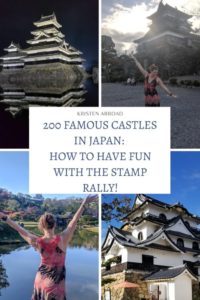
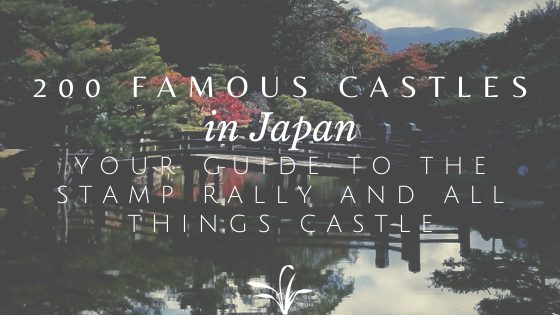
Each castle is listed because of its location – from Hokkaido to Okinawa. I have 25 in my collection now, and I’m getting more this April. So we have the same interest. Thank you for sharing your great experience.
Yes, for cultural and historical merits! I need to also get the “next” 100 castles book, 200 in all, so many to see! How long are you going to be in Japan in April? Do you know which ones you are going to?